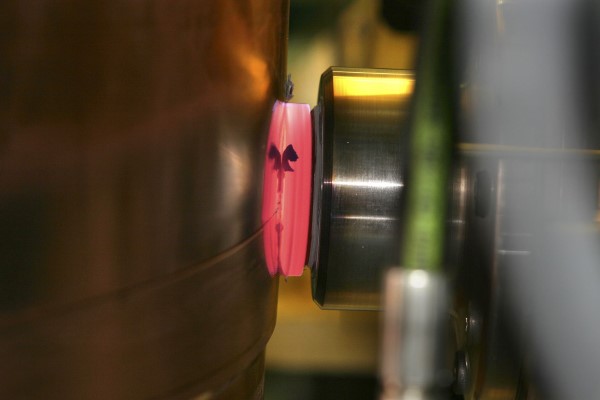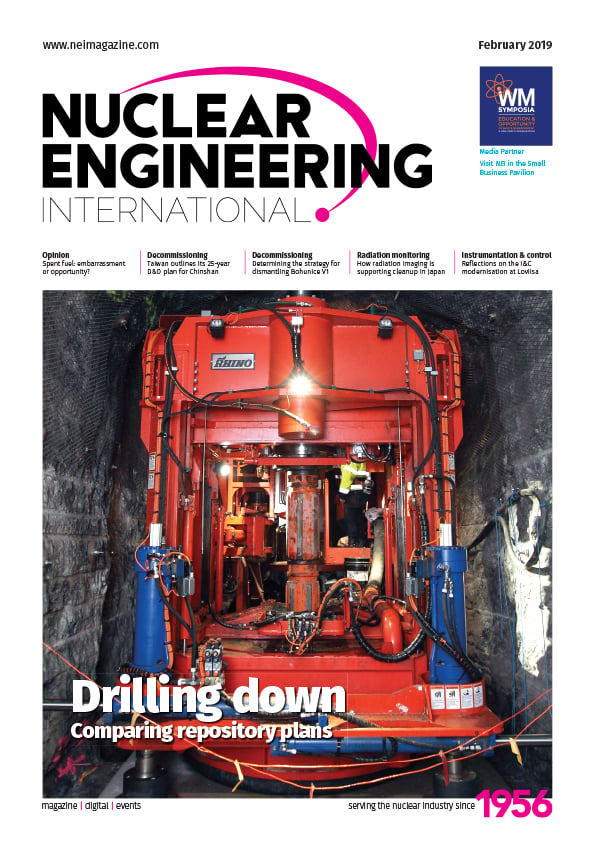Canada, Finland and Sweden are among the pioneers in research and development of methods for long-term management of spent nuclear fuel. LRQA's Kristina Gillin compares current status and plans in the three countries.
Friction stir welding of a copper lid in SKB’s canister laboratory in Oskarshamn, Sweden. Photo: Curt-Robert Lindqvist/SKB

For long-term management of spent nuclear fuel, Canada, Finland and Sweden have opted for the same multi-barrier concept. Many prerequisites for implementing a repository are the same, so this is hardly surprising. At the same time, there are differences.
Power production in full-scale reactors began in all three countries in the 1970s. Canada has 22 large heavy-water reactors, while the light-water reactors in Sweden and Finland total 12 and five, respectively (including Finland’s Olkiluoto 3, which is undergoing commissioning).
The spent fuel assemblies from these are first stored in pools directly adjacent to the reactors, and subsequently transferred to separate storage facilities. In Canada and Finland, these are located at the reactor sites. In Sweden, spent fuel is shipped to central storage, located in rock caverns approximately 30 metres below ground.
For managing the spent fuel long term, all three plan to encapsulate the fuel assemblies in reinforced copper canisters, surrounded by bentonite clay and place them in a deep geological repository located approximately 500 metres down in the bedrock.
Separate waste management organisations have been established in all three countries. Canada’s Nuclear Waste Management Organization (NWMO) and Finland’s Posiva are responsible only for long-term management of spent fuel, whereas the Swedish Nuclear Fuel and Waste Management Co (SKB) also has responsibility for interim storage and managing low- and intermediate-level waste. Funding is, in all three cases, secured through segregated trust funds, which are funded by the reactor owners.
Site selection
To identify a suitable site for a spent fuel repository, a systematic process has been outlined in all three countries. Common denominators include transparency and emphasis on a knowledgeable and willing host community.
In the Finnish programme, the siting process was completed 20 years ago. A construction licence – the first in the world for a repository for spent fuel – was issued in 2015. Today, construction is well underway and it is estimated that emplacement of canisters can begin in the mid-2020s. The siting process in Sweden is also complete. A licence application for the proposed method and site was submitted in 2011 and is pending government approval.
In both cases, the selected repository site is adjacent to a nuclear power plant (Olkiluoto and Forsmark, respectively). Public support is high in both local communities. Posiva’s Pasi Tuohimaa says: “The less you know, the more you fear. But here in Olkiluoto, people understand the nuclear safety culture.”
In Canada, site selection began in 2010 and 22 communities expressed interest. These have been narrowed down to five, all in Ontario, where most of the Canadian reactors are located. Laurie Swami, president and chief executive officer of NWMO, says: “By 2023, NWMO will have selected a preferred site. After that, we will enter into the regulatory approval phase.”
Encapsulation
Apart from the repository, each country will need a plant to encapsulate spent fuel in copper canisters. In shielded cells inside these plants, the fuel will be transferred into canisters, and the canisters welded shut and tested. In Canada and Finland, the encapsulation plant will be at the repository site, at surface level. The Swedish equivalent will be built at a different nuclear site, as an expansion of the existing central storage facility.
It was determined early on that copper would be suitable as a corrosion barrier in a spent fuel repository since there is no oxygen at depth in the rock. Spent fuel canisters also have to withstand high mechanical loads, because during glacial periods, the water-bearing rock formations at these latitudes are subject to pressure from several kilometres of overlaying ice.
Source: Nuclear Engineering International
This article is a summary of “Beyond the copper surface,” the cover story of the February 2019 issue of Nuclear Engineering International, written by LRQA's Kristina Gillin. You can access the full version at the publisher's website at February digital edition, Page 30 to 33.
For an exclusive 15% off your subscription to Nuclear Engineering International. Please click here quoting news15nuc.



